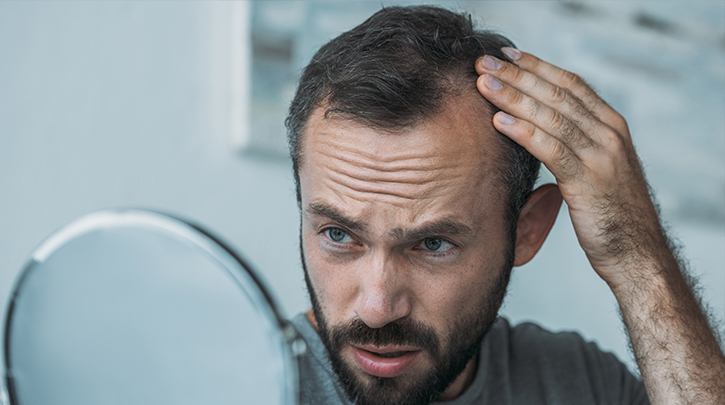
- Global
Get non-surgical solutions for today's top aesthetic concerns with Venus Treatments. Join thousands of satisfied patients worldwide!
- Loading...
- All Regions
Get non-surgical solutions for today's top aesthetic concerns with Venus Treatments. Join thousands of satisfied patients worldwide!

Hair loss is common throughout one’s life, particularly as we grow older, and it can occur for a whole host of reasons, so much so that the main cause can oftentimes be rather elusive. However, androgenic alopecia—or male- or female-pattern baldness as it’s more commonly called—tends to rank high among the most common types of hair loss, affecting approximately 50 million males and 30 million females in the United States alone. At the root of this particular type of hair loss, as well as a couple other types, are hormones. Just as hormones can be the key to maintaining healthy, luscious locks, it would seem that some hormones can have much more devastating effects on hair growth.
The average hair loss rate is about 100 strands a day, but natural hair loss tends to go unnoticed because the cycle of new growth evens it all out. It’s when the hair growth cycle gets interrupted and hair follicles become destroyed or dormant after shedding their last hair that noticeable thinning occurs. While family history (genetics), medical conditions, prescriptions, supplements, stress, and hair care can all play a role in a thinning hairline, most hair loss cases, including those of androgenic alopecia, can be traced back to hormones, specifically dihydrotestosterone (DHT).
A derivative of testosterone, DHT can both help and hinder hair growth. Regardless of gender, about one-tenth of the testosterone produced by the body daily is converted to DHT, which is approximately five-times more potent than testosterone and is responsible for many of the typical male characteristics, including body hair growth. In women, the steroid hormone dehydroepiandrosterone (DHEA) also increases testosterone and DHT levels (though this isn’t the case for men).
Unfortunately, in many cases, DHT can also impair hair growth via miniaturization. In these instances, an enzyme called type II 5-alpha reductase that is located in hair follicle oil glands converts testosterone to DHT, which can then bind to receptors in your hair follicles, causing them to shrink, weaken, and eventually become inactivated. Over time, healthy hair is unable to survive in the affected hair follicles, leading to long-term increased hair loss and a lack of hair growth.
For the most part, because women have a very small fraction of the amount of testosterone often found in men, women can still experience DHT-triggered hair loss, but it more often appears as thinning rather than a receding hairline that is more typical in males. As well, in women, oestrogen plays a protective role against DHT, encouraging hair to stay in its growth phase, but when oestrogen levels drop during menopause or post-pregnancy, DHT increases and hair loss and thinning result.
Of course, hormone production levels, like hair growth, also follow cycles, which is the main reason men and women experience aging at different rates. For women, hormones shift and change throughout different stages of our lives, including during puberty, pregnancy, childbirth, menopause, and even with our monthly cycles. For men, testosterone levels tend to decline more gradually, with an average drop of 10% each decade starting in their 30s. Depending on how these hormonal cycles correlate with one’s hair growth cycle, hair loss and thinning may appear to dramatically develop short-term but show signs of slowing down long-term.
However, there is one more significant note to make.
As studies have proven, higher serum levels of DHT aren’t so much to blame as a combination of higher DHT concentrations and genetics. In other words, it’s not the amount of DHT alone that leads to hair loss and baldness, but rather the sensitivity of your hair follicles to DHT, a factor that is determined by genetics. More specifically, the AR gene determines the number of DHT receptors found on hair follicles that interact with the hormone. The more receptors there are, as determined by the AR gene, the more sensitive hair follicles are to DHT. For those who are particularly sensitive then, even lower levels of DHT can result in significant hair loss.
While there are a few ways to adjust hormone production levels, lowering DHT levels alone won’t reverse the effects of DHT-caused hair loss. Those hair follicles that have been rendered inactive are now much less likely to be able to support healthy hair growth moving forward. Instead, treatments via a minimally invasive hair restoration procedure like NeoGraft® will transplant healthy, active hair follicles to those areas affected by hair loss.
NeoGraft® hair restoration treatments utilize an industry-standard, innovative hair restoration method called Follicular Unit Extraction (FUE). This method extracts individual hair follicles from a healthy donor site, where hair growth remains thicker—usually the lower-back or sides of the head. Each individual follicle generally contains one to three individual hairs. Follicles are sorted by the number of hairs they contain, then strategically re-implanted in areas showing hair loss and thinning in a way that best represents your natural hairline and hair growth. Results continue to improve in the weeks following the proccedure, with optimal outcomes expected nine to 12 months post-treatment. Finally, because NeoGraft® uses the FUE method, it remains a leader in hair restoration as one of the least invasive solutions for male and female patients experiencing hair loss, with no linear scarring and a faster recovery period for patients.
Interested in learning how NeoGraft® hair loss solutions may be customized to meet your aesthetic goals? Use the clinic finder to locate a provider near you today to book your initial consultation.
Find a certified Venus Treatments provider near you today who specializes in today’s top aesthetic medical solutions.



Search below to find a provider near you and to learn about our non-surgical aesthetic treatments with ARTAS®, NeoGraft®, Venus Bliss™, Venus Blilss MAX™, Venus Versa™, Venus Legacy™ Venus Versa™ Pro, Venus Velocity™, Venus Viva™ MD, and Venus Glow™.
For more information call: (888) 907-0115 // [email protected] // 235 Yorkland Blvd., Suite 900, Toronto, ON, M2J 4Y8 Canada
REGULATORY CLEARANCES [ More ]
Venus Bliss™ is cleared by the FDA and licensed by Health Canada for non-invasive lipolysis of the abdomen and flanks in individuals with a Body Mass Index (BMI) of 30 or less, with the diode laser applicators. The (MP)2 applicator is cleared by the FDA for temporary reduction in the appearance of cellulite, and licensed by Health Canada for temporary increase of skin tightening, temporary circumferential reduction, and temporary cellulite reduction. Venus Bliss™ has CE Mark as a non-invasive medical aesthetic device enabling a comprehensive approach leading to body contouring, addressing fat reduction, skin tightening, circumference reduction, and cellulite reduction.
Venus Versa™ is cleared by the FDA, licensed by Health Canada, and has CE Mark as a multi-application device intended to be used in aesthetic and cosmetic procedures. The SR515 and SR580 applicators are cleared by the FDA, licensed by Health Canada, and have CE Mark for the treatment of benign pigmented epidermal and cutaneous lesions and treatment of benign cutaneous vascular lesions. The HR650/HR650XL and HR690/HR690XL applicators are cleared by the FDA, licensed by Health Canada, and have CE Mark for the removal of unwanted hair and to effect stable long-term or permanent hair reduction for Fitzpatrick skin types I-IV. The AC Dual applicator is cleared by the FDA, licensed by Health Canada, and has CE Mark for the treatment of acne vulgaris. The DiamondPolar™ and OctiPolar™ applicators on the Venus Versa™ system are cleared by the FDA for non-invasive treatment of moderate to severe facial wrinkles and rhytides on females with Fitzpatrick skin types I-IV. The DiamondPolar™ applicator is licensed by Health Canada and has CE Mark for non-invasive treatment of moderate to severe facial wrinkles and rhytides on females with Fitzpatrick skin types I-IV. The OctiPolar™ applicator on the Venus Versa™ system is licensed by Health Canada and has CE Mark for temporary body contouring via skin tightening, circumferential reduction, and cellulite reduction. The NanoFractional RF™ (Viva) applicator is cleared by the FDA, licensed by Health Canada, and has CE Mark for dermatological procedures requiring ablation and resurfacing of the skin.
NeoGraft® is cleared by the FDA, licensed by Health Canada and has CE Mark with indication for use in suction-assisted follicular extraction and re-implantation. It is an auto-graft system and can be used on both male and female patients.
ARTAS iX™ is cleared by the FDA, licensed by Health Canada and has CE Mark with indication for use for harvesting hair follicles from the scalp in men diagnosed with androgenic alopecia (male pattern hair loss) who have black or brown straight hair. ARTAS iX™ is intended to assist physicians in identifying and extracting hair follicular units from the scalp during hair transplantation; creating recipient sites; and implanting harvested hair follicles.
Venus Legacy™ is cleared by the FDA for the non-invasive treatment of moderate to severe facial wrinkles and rhytides in females with Fitzpatrick skin types I-IV with the OctiPolar™ and DiamondPolar™ applicators, and temporary reduction in the appearance of cellulite with the 4D Body (LB2) and 4D Face (LF2) applicators. It is licensed by Health Canada and has CE Mark for the temporary increase of skin tightening, temporary circumferential reduction, temporary cellulite reduction, and temporary wrinkle reduction.
Venus Velocity™ is cleared by the FDA, licensed by Health Canada and has CE Mark for hair removal, permanent hair reduction (defined as the long-term stable reduction in the number of hairs re-growing when measured at 6, 9 and 12 months after the completion of a treatment regimen), and the treatment of pseudofolliculitis barbae for all Fitzpatrick skin types.
Venus Fiore™ received regulatory approval in Israel for aesthetic and functional treatment of the vagina, labia and mons pubis. Venus Fiore™ is available for sale in India, Hong Kong, and other selected Asian countries.
Venus Viva™ is cleared by the FDA, licensed by Health Canada, and has CE Mark for dermatological procedures requiring ablation and resurfacing of the skin. The DiamondPolar™ applicator is cleared by the FDA, licensed by Health Canada and has CE Mark for the treatment of moderate to severe wrinkles and rhytides in Fitzpatrick skin types I-IV.
Venus Freeze Plus™ is cleared by the FDA for the non-invasive treatment of moderate to severe facial wrinkles and rhytides in females with Fitzpatrick skin types I-IV. It is licensed by Health Canada for temporary skin tightening, and temporary reduction in the appearance of cellulite on the abdomen and flanks, using the DiamondPolar™ and OctiPolar™ applicators. The DiamondPolar™ applicator on Venus Freeze Plus™ has CE Mark for the non-invasive treatment of moderate to severe facial wrinkles and rhytides, and the increase of skin tightening, temporary circumferential reduction, and cellulite reduction with the OctiPolar™ applicator.
Venus Heal™ is licensed by Health Canada and can be used for the treatment of both acute and chronic disorders of the musculoskeletal system, such as muscle spasms, back pain, and soft tissue injuries, and results in effects such as pain relief, myorelaxation, increase of local blood circulation, and edema reduction. In the U.S., Venus Heal™ is cleared by the FDA for the relief of minor muscle aches and pain, relief of muscle spasm, and temporary improvement of local blood circulation. These indications enable the treatment of certain soft tissue injuries and conditions.
Venus Glow™ is cleared by the FDA as a Class I motorized dermabrasion device. It provides a dermal rejuvenation treatment that works to open up and deep-clean pores. Venus Concept is the exclusive distributor for Venus Glow™.
Venus Epileve™ is licensed by Health Canada and has CE Mark for hair removal, permanent hair reduction (defined as the long-term stable reduction in the number of hairs re-growing when measured at 6, 9 and 12 months after the completion of a treatment regimen), and the treatment of pseudofolliculitis barbae for all Fitzpatrick skin types. Venus Epileve™ is also CE-Marked for hirsutism.
Venus Freeze™ is cleared by the FDA for the non-invasive treatment of moderate to severe facial wrinkles and rhytides in females with Fitzpatrick skin types I-IV. It is licensed by Health Canada for temporary skin tightening, and temporary reduction in the appearance of cellulite on the abdomen and flanks, using the DiamondPolar™ and OctiPolar™ applicators. The DiamondPolar™ applicator on Venus Freeze™ has CE Mark for the non-invasive treatment of moderate to severe facial wrinkles and rhytides, and the increase of skin tightening, temporary circumferential reduction, and cellulite reduction with the OctiPolar™ applicator.
Venus Swan™ is cleared by the FDA for the non-invasive treatment of moderate to severe facial wrinkles and rhytides, and licensed by Health Canada for the non-invasive treatment of cellulite reduction, skin tightening, and temporary reduction in the appearance of stretch marks.
Copyright © 2025 Venus Concept. All rights reserved.
You are entering our website. For other countries/regions and language options, please click the SELECT A DIFFERENT REGION button below.
SELECT A DIFFERENT REGIONAre you looking to get a treatment? Please visit our patient website to learn more.
Click HereUnsure which aesthetic treatment is right for you? Take this quick and easy quiz to discover treatments that suit your needs.
Get Started